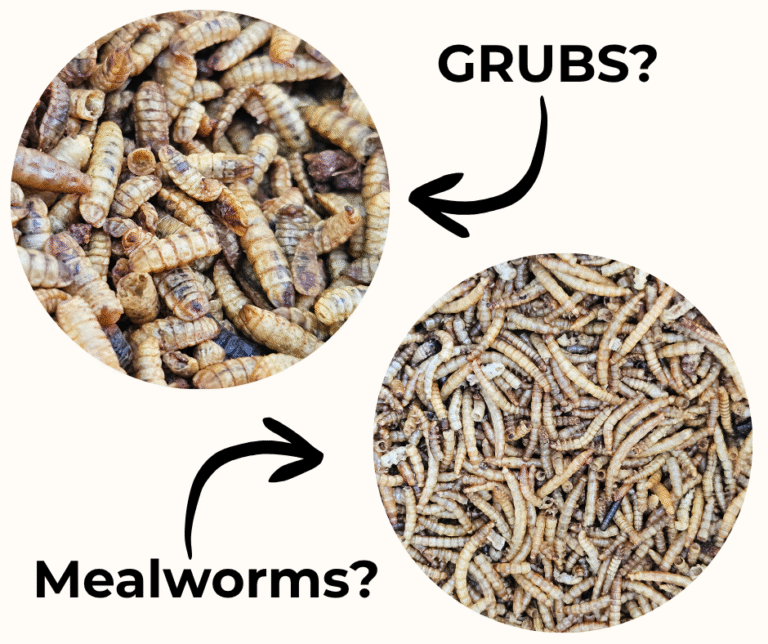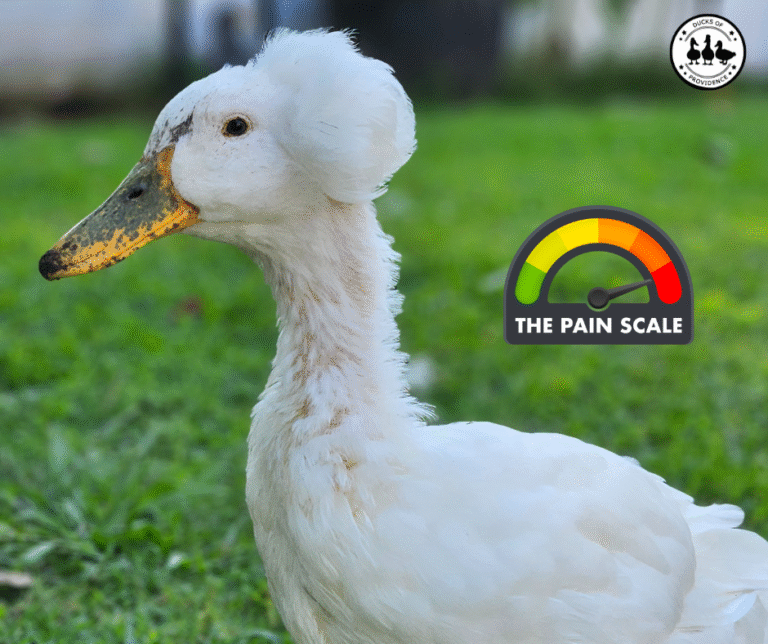
BSFL vs. Mealworms for Your Feathered Friends: The Great Grub Debate
Last updated on July 22nd, 2024 at 04:47 pm
Today, we’re exploring a topic that’s wriggling its way into the hearts (and stomachs) of our feathered friends: the benefits of Black Soldier Fly Larvae (BSFL) compared to the ever-popular mealworms. Let’s see which one comes out on top!
Disclaimer: I may earn a commission if you buy products or services through my affiliate links. This will not affect the price you pay. I only recommend products or services that I believe will be beneficial to my readers.
Meet the Contenders
Black Soldier Fly Larvae (BSFL)
BSFL are the larvae of the Black Soldier Fly, a fascinating insect known for its efficiency in breaking down organic waste. These little guys are packed with essential nutrients and have been gaining popularity as a sustainable food source for poultry, including our beloved ducks.

Mealworms
Mealworms, the larvae of the darkling beetle, have long been a favorite treat for duck keepers. They are easy to find and relatively inexpensive, and ducks absolutely love them. But how do they stack up against BSFL in terms of nutritional benefits and sustainability?

Nutritional Showdown
Let’s break down the nutritional content of BSFL and mealworms to see how they compare:
| Nutrient | BSFL (% Dry Weight) | Mealworms (% Dry Weight) |
|---|---|---|
| Protein | 40-45% | 20-30% |
| Fat | 25-35% | 13-20% |
| Calcium | 5-8% | 0.05-0.1% |
| Phosphorus | 0.6-1.5% | 0.6-1% |
| Fiber | 5-10% | 2-4% |
Protein Powerhouse
Both BSFL and mealworms are excellent sources of protein, which is crucial for the growth and health of ducks. However, BSFL often edges out mealworms with a higher protein content. This makes BSFL an outstanding choice for supporting muscle development and feather growth.
Calcium Content
One of the standout features of BSFL is their high calcium content. Calcium is vital for ducks, particularly laying females, as it supports strong eggshells and overall bone health. BSFL boasts a calcium content that can be up to 50 times higher than mealworms! This means fewer worries about supplementing your ducks’ diet with additional calcium sources.
Fat Content
While both larvae types provide necessary fats, BSFL tend to have a more balanced fat profile. Mealworms can be higher in fat, which, while beneficial in moderation, can contribute to obesity if fed in excess. BSFL offer a more moderate fat content, making them a healthier everyday snack option.
Sustainability and Environmental Impact
Sustainable Superstars
BSFL are celebrated for their environmental benefits. They are efficient waste decomposers, capable of transforming organic waste into high-quality protein. This process not only reduces waste but also provides a sustainable food source. On the other hand, mealworm farming, while relatively eco-friendly, doesn’t match the waste-reducing prowess of BSFL.
Resource Efficiency
Raising BSFL requires fewer resources, such as water and feed, compared to mealworms. This efficiency makes BSFL a more sustainable option, aligning with eco-conscious practices that many of us strive to incorporate into our duck-keeping routines.
Practical Considerations
Availability and Cost
Mealworms have long been a staple in pet stores and online marketplaces, making them easily accessible and often cheaper. BSFL, while growing in availability, can sometimes be a bit pricier and harder to find, depending on your location. However, as demand increases, we’re likely to see more competitive pricing and accessibility for BSFL.
Storage and Handling
Both BSFL and mealworms are relatively easy to store and handle. They can be kept alive in simple setups or dried for convenience. Some duck keepers find BSFL a bit less wriggly and more manageable, but this boils down to personal preference.
Where to Buy
If you’re interested in trying out these nutritious treats for your ducks, here are some reputable stores where you can purchase BSFL:
Grubbly Farms

Grubbly Farms is a fantastic company dedicated to providing sustainable and nutritious treats for backyard poultry. Their innovative approach centers around using black soldier fly larvae, a rich and eco-friendly source of protein, to create healthy snacks that ducks and chickens absolutely love.
Not only do their products promote the well-being of your feathered friends by supporting strong feathers and egg production, but they also contribute to a more sustainable planet by utilizing waste and reducing the need for traditional feed sources. With Grubbly Farms, you can feel good about giving your flock a treat that’s both delicious and environmentally responsible.
Grub Terra

GrubTerra is a remarkable company committed to transforming food waste into high-quality, nutritious treats for poultry. They specialize in black soldier fly larvae, which are packed with essential nutrients that promote the health and vitality of ducks and chickens.
By harnessing the power of these larvae, GrubTerra offers an eco-friendly solution that supports sustainable agriculture while providing your flock with a delicious and protein-rich snack. Their dedication to sustainability and animal welfare makes GrubTerra a standout choice for poultry enthusiasts looking to make a positive impact on both their birds and the environment.
FlyGrubs

FlyGrubs is a standout company in the world of poultry treats, renowned for its commitment to sustainability and animal health. They produce high-protein snacks for ducks and chickens made from black soldier fly larvae, which are not only delicious but also packed with essential nutrients. These grubs support feather health, egg production, and overall vitality, making them a fantastic addition to your flock’s diet.
FlyGrubs takes pride in their eco-friendly approach, utilizing food waste to rear the larvae and thus contributing to a greener planet. For poultry keepers seeking nutritious and sustainable treats, FlyGrubs is a top-notch choice.
The Verdict
While both BSFL and mealworms offer excellent nutritional benefits for your ducks, BSFL stands out as a superior option due to its higher protein and calcium content, as well as its impressive sustainability credentials. That said, mealworms still have their place as a readily available and much-loved treat.
Ultimately, the best choice depends on your specific needs and circumstances. Mixing both larvae types into your ducks’ diet can provide a balanced array of nutrients and keep your feathered friends happy and healthy.
What do you think? Have you tried feeding your ducks BSFL or mealworms? Share your experiences and any tips you have in the comments below. Let’s keep our ducks quacking and thriving together!
Learn more about a healthy duck diet in the following blog posts: What do Pet Ducks Eat? A Guide to a Healthy and Nutritious Pet Duck Diet or Essential Nutritional Needs of Ducks: A Complete Overview



